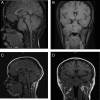Beat the giant: case of a giant prolactinoma during pregnancy on cabergoline
- PMID: 30159146
- PMCID: PMC6109208
- DOI: 10.1530/EDM-18-0099
Beat the giant: case of a giant prolactinoma during pregnancy on cabergoline
Abstract
Giant prolactinomas are a rare entity; during pregnancy, the risk for complications associated with these tumors is higher. Here, we report a case of a young woman who had an invasive, giant prolactinoma post resection with residual disease who became pregnant. This patient was treated with cabergoline to prevent tumor expansion in pregnancy, resulting in the uneventful delivery of a healthy baby boy.
Learning points: Giant prolactinoma can cause both diagnostic and therapeutic challenges given their atypical presentation.Accurate diagnosis is paramount to avoid unnecessary surgical intervention or pituitary irradiation.This case demonstrates the effectiveness and safety of CAB therapy during pregnancy.
Figures


Similar articles
-
Restoration of fertility in a woman with giant prolactinoma in response to cabergoline treatment.Endocrinol Diabetes Metab Case Rep. 2019 Sep 6;2019:EDM190023. doi: 10.1530/EDM-19-0023. Online ahead of print. Endocrinol Diabetes Metab Case Rep. 2019. PMID: 31967975
-
Giant prolactinomas in men: efficacy of cabergoline treatment.Clin Endocrinol (Oxf). 2003 May;58(5):662-70. doi: 10.1046/j.1365-2265.2003.01770.x. Clin Endocrinol (Oxf). 2003. PMID: 12699451
-
[Atypical presentation of a giant prolactinoma in a 15-year-old boy].Arch Argent Pediatr. 2018 Apr 1;116(2):e325-e330. doi: 10.5546/aap.2018.e325. Arch Argent Pediatr. 2018. PMID: 29557627 Spanish.
-
Cabergoline versus bromocriptine for the treatment of giant prolactinomas: A quantitative and systematic review.Metab Brain Dis. 2018 Jun;33(3):969-976. doi: 10.1007/s11011-018-0217-3. Epub 2018 Mar 15. Metab Brain Dis. 2018. PMID: 29546691
-
Prolactinomas, cabergoline, and pregnancy.Endocrine. 2014 Sep;47(1):64-9. doi: 10.1007/s12020-014-0334-7. Epub 2014 Jul 2. Endocrine. 2014. PMID: 24985062 Review.
References
-
- Siddiqui A, Chew N, Miszkiel K. Unusual orbital invasion by a giant prolactinoma. British Journal of Radiology 2008. 81 259–262. - PubMed
LinkOut - more resources
Full Text Sources
Other Literature Sources

